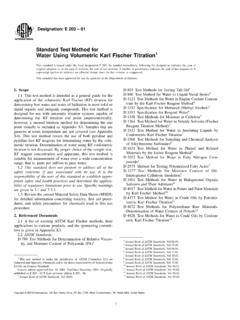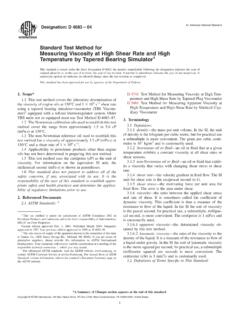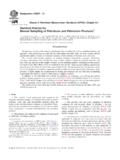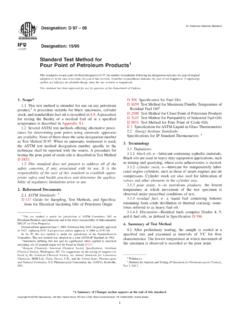Transcription of Standard Test Method for Conradson Carbon Residue of ...
1 Designation: D 189 06 2 Designation: 13/94An American National StandardBritish Standard 4380 Standard Test Method forConradson Carbon Residue of petroleum products1 This Standard is issued under the fixed designation D 189; the number immediately following the designation indicates the year oforiginal adoption or, in the case of revision, the year of last revision. A number in parentheses indicates the year of last reapproval. Asuperscript epsilon ( ) indicates an editorial change since the last revision or Standard has been approved for use by agencies of the Department of Defense.
2 1 NOTE Removed asbestos reinstated original research report footnote editorially in October 2007. 2 NOTE Updated Summary of Changes and added to research report footnote editorially in December Scope* This test Method covers the determination of the amountof Carbon Residue (Note 1) left after evaporation and pyrolysisof an oil, and is intended to provide some indication of relativecoke-forming propensities. This test Method is generally ap-plicable to relatively nonvolatile petroleum products whichpartially decompose on distillation at atmospheric products containing ash-forming constituents asdetermined by Test MethodD 482or IP Method 4 will have anerroneously high Carbon Residue , depending upon the amountof ash formed (Note 2andNote 4).
3 NOTE1 The termcarbon residueis used throughout this test methodto designate the carbonaceous Residue formed after evaporation andpyrolysis of a petroleum product under the conditions specified in this testmethod. The Residue is not composed entirely of Carbon , but is a cokewhich can be further changed by pyrolysis. The termcarbon residueiscontinued in this test Method only in deference to its wide common Values obtained by this test Method are not numerically thesame as those obtained by Test MethodD 524. Approximate correlationshave been derived (seeFig.)
4 , but need not apply to all materialswhich can be tested because the Carbon Residue test is applied to a widevariety of petroleum The test results are equivalent to Test MethodD 4530, (seeFig. ).NOTE4 In diesel fuel, the presence of alkyl nitrates such as amylnitrate, hexyl nitrate, or octyl nitrate causes a higher Residue value thanobserved in untreated fuel, which can lead to erroneous conclusions as tothe coke forming propensity of the fuel. The presence of alkyl nitrate inthe fuel can be detected by Test MethodD The values stated in SI units are to be regarded as thestandard.
5 The values given in parentheses are for Standard does not purport to address all of thesafety concerns, if any, associated with its use. It is theresponsibility of the user of this Standard to establish appro-priate safety and health practices and determine the applica-bility of regulatory limitations prior to Referenced Standards:2D 482 Test Method for Ash from petroleum ProductsD 524 Test Method for Ramsbottom Carbon Residue ofPetroleum ProductsD 4046 Test Method for Alkyl Nitrate in Diesel Fuels bySpectrophotometryD 4057 Practice for Manual Sampling of petroleum andPetroleum ProductsD 4175 Terminology Relating to petroleum , PetroleumProducts, and LubricantsD 4177 Practice for Automatic Sampling of petroleum andPetroleum ProductsD 4530 Test Method for Determination of Carbon Residue (Micro Method )
6 E1 Specification for ASTM Liquid-in-Glass ThermometersE 133 Specification for Distillation Equipment3. :1 This test Method is under the jurisdiction of ASTM Committee D02 onPetroleum Products and Lubricants and is the direct responsibility of on Analysis of edition approved Nov. 1, 2006. Published December 2006. Originallyapproved in 1924. Last previous edition approved in 2005 as D the IP, this test Method is under the jurisdiction of the StandardizationCommittee and is issued under the fixed designation IP 13.
7 The final numberindicates the year of last revision. This test Method was adopted as a joint ASTM IPstandard in procedure is a modification of the original Conradson Method and apparatusfor Carbon Test and Ash Residue in petroleum Lubricating Oils. SeeProceedings,Eighth International Congress of Applied Chemistry, New York, Vol 1, p. 131,September 1912; alsoJournal of Industrial and Engineering Chemistry, IECHA,Vol 4, No. 11, December 1965, a new Fig. 2 on reproducibility and repeatability combining ASTM andIP precision data replaced old Fig.
8 2 andNote referenced ASTM standards, visit the ASTM website, , orcontact ASTM Customer Service at ForAnnual Book of ASTMS tandardsvolume information, refer to the Standard s Document Summary page onthe ASTM *A Summary of Changes section appears at the end of this ASTM International, 100 Barr Harbor Drive, PO Box C700, West Conshohocken, PA 19428-2959, United Residue ,n the Residue formed by evaporationand thermal degradation of a Carbon containing The Residue is not composed entirely ofcarbon but is a coke that can be further changed by carbonpyrolysis.
9 The term Carbon Residue is retained in deference toits wide common 41754. Summary of Test A weighed quantity of sample is placed in a crucible andsubjected to destructive distillation. The Residue undergoescracking and coking reactions during a fixed period of severeheating. At the end of the specified heating period, the testcrucible containing the carbonaceous Residue is cooled in adesiccator and weighed. The Residue remaining is calculated asa percentage of the original sample, and reported as Conradsoncarbon Significance and The Carbon Residue value of burner fuel serves as arough approximation of the tendency of the fuel to formdeposits in vaporizing pot-type and sleeve-type burners.
10 Simi-larly, provided alkyl nitrates are absent (or if present, providedthe test is performed on the base fuel without additive) thecarbon Residue of diesel fuel correlates approximately withcombustion chamber The Carbon Residue value of motor oil, while at one timeregarded as indicative of the amount of carbonaceous depositsa motor oil would form in the combustion chamber of anengine, is now considered to be of doubtful significance due tothe presence of additives in many oils. For example, anash-forming detergent additive may increase the Carbon residuevalue of an oil yet will generally reduce its tendency to The Carbon Residue value of gas oil is useful as a guidein the manufacture of gas from gas oil, while Carbon residuevalues of crude oil residuums, cylinder and bright stocks, areuseful in the manufacture of Apparatus(seeFig.)







